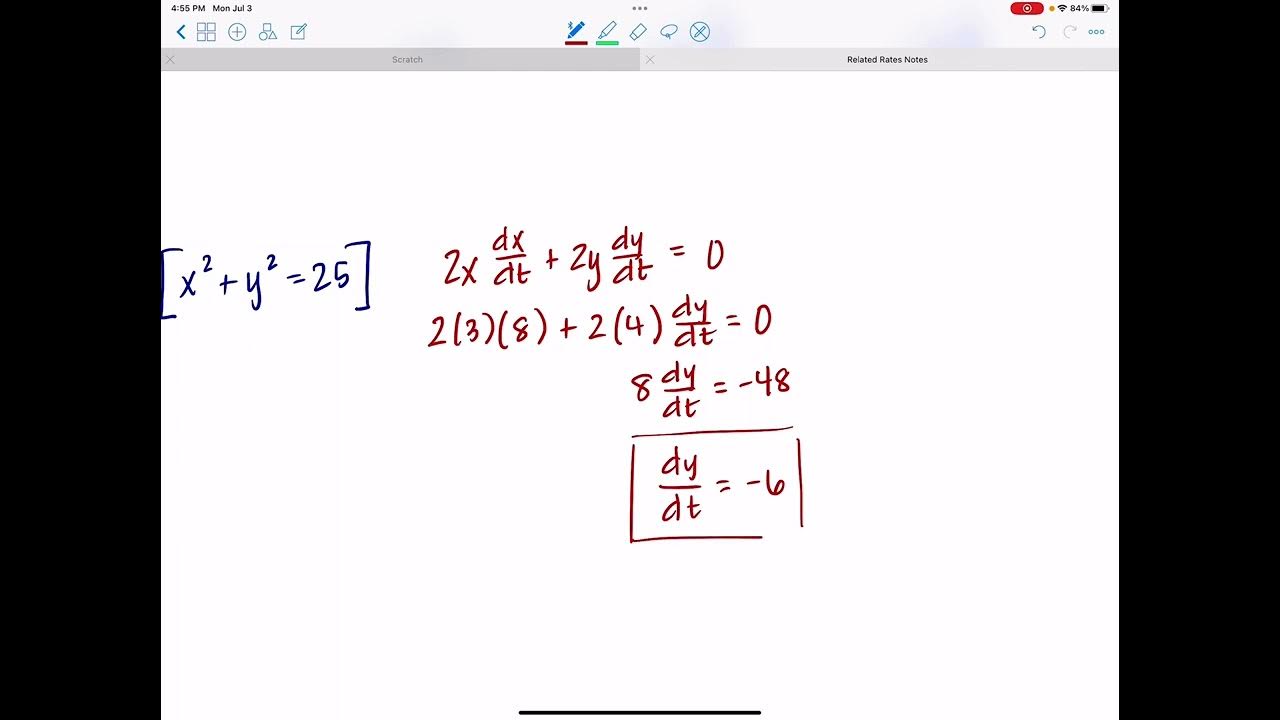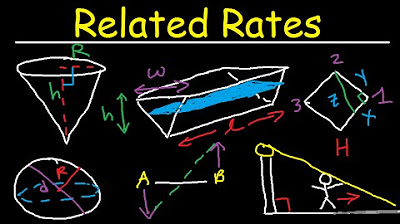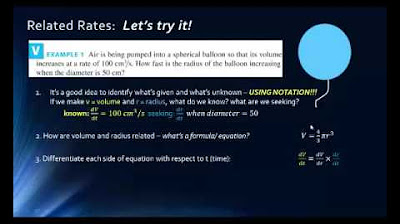More Related Rates
TLDRThis script discusses complex related rate problems involving geometry, primarily focusing on the rate of change in various scenarios. It covers topics such as water draining from a cylinder, a rectangle's perimeter growth, a cone's volume change, and the angle of elevation of a space shuttle. Each problem is solved by establishing proportionality relationships or using geometric formulas, demonstrating the application of calculus in real-world problems.
Takeaways
- 📚 The video discusses complex related rate problems involving proportionality relationships and geometric properties.
- 🌊 A cylinder losing water at a rate of 10 cubic feet per minute leads to a calculation of the rate of change of the water's height using volume and area relationships.
- 📏 The rate of change of a rectangle's perimeter is calculated when its width is increasing at a rate of 5 centimeters per second, highlighting the importance of setting up equations with one variable.
- 🏔️ A cone problem involves dumping sand onto a pile, where the radius is three times the height, and the rate of change in height is determined when the radius is four feet.
- 🚀 A person watching a space shuttle launch from a distance involves calculating the rate of change in distance between the person and the shuttle as the shuttle ascends.
- 🔦 A ladder sliding down a wall problem involves using trigonometric relationships to find the rate of change of the angle between the floor and the ladder.
- 🌳 A shadow and walker problem requires setting up a proportion to describe the relationship between the triangles formed by the person, the lamp post, and their shadows.
- 🌞 The rate of change in the length of a shadow is calculated as a person walks away from a lamp post, emphasizing the use of proportionality in solving related rate problems.
- 🌌 A cone-shaped tank draining water involves determining the rate of change in the radius when the height is 15 inches, using the volume formula for a cone.
- 🔍 The video emphasizes the importance of simplifying problems by substituting variables and focusing on one variable at a time to make calculations more manageable.
Q & A
What is the rate of change of the height of water in a cylinder losing water at a rate of 10 cubic feet per minute, given the radius is 10 feet?
-The rate of change of the height of the water (dh/dt) is -10/(100π) feet per minute. This is derived from the volume formula of a cylinder (V = πr²h) and the given rate of change of volume (dV/dt = -10 cubic feet per minute).
How fast is the perimeter of a rectangle growing if its width is growing at 5 centimeters per second, and the length is twice the width?
-The perimeter (P) of the rectangle is initially 6x, where x is the width. Since the width is growing at 5 cm/s, the rate of change of the perimeter (dP/dt) is 6 times the rate of change of the width (dx/dt), which is 30 cm/s.
What is the rate of change in the height of a sand pile when the radius is four feet, given the volume of the cone is increasing at a rate of five cubic feet per minute?
-The rate of change in the height (dh/dt) is 5/(16π) feet per minute. This is calculated using the volume formula of a cone (V = 1/3πr²h) and the given proportionality between the radius and height (r = 3h).
How fast is the distance between a person standing 3000 feet from a launch pad and a space shuttle rising at 800 feet per second changing?
-The rate of change in the distance (dr/dt) is 640 feet per second. This is determined using the Pythagorean theorem and the given rates of change in the horizontal (dx/dt = 0) and vertical (dy/dt = 800) distances.
What is the rate of change in the angle of elevation from a person to a space shuttle rising at 800 feet per second, given the person is 3000 feet from the launch pad?
-The rate of change in the angle of elevation (dθ/dt) is 72/(25π) radians per second. This is derived from the tangent function and the given rates of change in the vertical distance (dy/dt = 800) and the horizontal distance (dx/dt = 0).
How fast is the angle between the floor and a ladder sliding down a wall changing if the ladder is 10 feet long and the bottom end is moving away from the wall at 2 feet per second?
-The rate of change in the angle (dθ/dt) is -2/6 radians per second. This is calculated using the cosine function and the given rates of change in the horizontal (dx/dt = 2) and vertical (dy/dt) distances.
How fast is the length of a shadow increasing if a person is walking away from a lamp post at 2 feet per second, and the person is initially 10 feet away from the lamp post?
-The rate of change in the length of the shadow (dx/dt) is 1.5 feet per second. This is derived from the proportionality relationship between the person's distance from the lamp post and the shadow's length.
What is the rate of change in the height of water in a cone-shaped tank when the height is 15 inches, given the tank is draining at a rate of three cubic inches per second?
-The rate of change in the radius (dr/dt) is -3/(90π) inches per second. This is calculated using the volume formula of a cone (V = 1/3πr²h) and the given rates of change in the volume (dV/dt = -3 cubic inches per second).
How can you simplify the process of solving related rate problems involving geometric shapes?
-One effective method is to establish a proportionality relationship or a single variable substitution, which simplifies the problem to a one-variable calculus problem. This approach reduces the complexity and minimizes the chance of making arithmetic errors.
What is the key to solving the ladder sliding down a wall problem involving trigonometric functions?
-The key is to use the appropriate trigonometric identity and derivative. For example, using cosine to relate the horizontal distance (x) and the ladder's length (r) simplifies the problem, and taking the derivative with respect to time gives the rate of change in the angle.
Outlines
📚 Related Rate Problems with a Cylinder
This paragraph discusses a problem involving a cylinder losing water at a rate of 10 cubic feet per minute. The radius of the cylinder is constant at 10 feet, and the challenge is to find the rate of change of the water's height. The solution involves using the volume formula for a cylinder (V = πr²h) and taking the derivative with respect to time, resulting in dV/dt = 100π(dh/dt). By substituting dV/dt = -10, the rate of change of height (dh/dt) is calculated as -10/100π, simplifying the problem to a single variable.
📏 Growing Rectangle and its Perimeter
The second paragraph presents a problem of a rectangle with a length that is twice its width, which is increasing in size. The width is growing at a rate of 5 centimeters per second. The task is to determine how fast the perimeter is growing. The perimeter is calculated as 6x (where x is the width), and by taking the derivative with respect to time, the rate of change of the perimeter (dP/dt) is found to be 6(dx/dt). Substituting dx/dt = 5, the perimeter growth rate is determined to be 30 centimeters per second.
🏔️ Cone Sand Pile Volume and Height Change
This paragraph explores a cone-shaped sand pile where sand is being dumped at a rate of 5 cubic feet per minute. The radius of the sand pile is three times the height. The goal is to find the rate of change in the height of the pile when the radius is four feet. The volume of a cone (V = 1/3πr²h) is used, and by substituting r = 3h, the formula is simplified to V = πh³. The derivative dV/dt = 9πh²(dh/dt) is then used to solve for the rate of change of height (dh/dt) when r = 4, resulting in dh/dt = 5/(16π).
🚀 Space Shuttle and Changing Distance
The fourth paragraph describes a scenario where a person is standing 3000 feet from a launch pad, and a space shuttle is rising at a rate of 800 feet per second. The challenge is to find the rate of change of the distance between the person and the shuttle. Using the Pythagorean theorem (x² + y² = r²), the relationship between the distances is established, and by differentiating with respect to time, the rate of change of the distance (dr/dt) is calculated to be 640 feet per second.
📐 Angle of Elevation from a Person to a Space Shuttle
In this paragraph, the focus is on calculating the rate of change of the angle of elevation from a person to a space shuttle, given the same conditions as the previous paragraph. The tangent function is used to relate the angle to the distances, and by differentiating, the rate of change of the angle (dθ/dt) is found. The derivative involves the secant squared of the angle, and by substituting the known rates and distances, the rate of change of the angle is calculated in radians per second.
🪜 Ladder Sliding Down a Wall
The sixth paragraph discusses a ladder sliding down a wall. The ladder is 10 feet long, and its top is 6 feet above the ground. The challenge is to find the rate of change of the angle between the ladder and the ground as the ladder slides. Using the cosine function, the relationship between the distances and the angle is established, and by differentiating, the rate of change of the angle (dθ/dt) is calculated to be negative two-sixths radians per second.
🚶♂️ Shadow and Walker Proportionality
This paragraph presents a problem involving a person walking away from a lamp post, casting a shadow. The person is 10 feet away from the lamp post, and the lamp post is 20 feet tall. The person is walking away at a rate of 2 feet per second, and the task is to find how fast the length of the shadow is increasing. By setting up a proportion based on the similar triangles formed by the person and the lamp post, the relationship between the distances is established, and by differentiating, the rate of change of the shadow's length (dx/dt) is calculated to be one and a half feet per second.
🌊 Water Draining from a Cone-Shaped Tank
The final paragraph discusses a cone-shaped tank with a radius of 10 inches and a height of 25 inches, draining water at a rate of 3 cubic inches per second. The challenge is to find the rate of change of the radius when the height is 15 inches. By setting up a proportionality relationship between the radius and height, and using the volume formula for a cone (V = 1/3πr²h), the rate of change of the radius (dr/dt) is calculated to be negative three divided by 90π inches per second.
Mindmap
Keywords
💡Related Rate Questions
💡Proportionality Relationship
💡Cylinder
💡Derivative
💡Surface Area
💡Volume
💡Rectangle
💡Cone
💡Space Shuttle
💡Angle of Elevation
💡Ladder Sliding Down a Wall
💡Shadow and Walker Problem
Highlights
Introduction to related rate problems involving complex analysis and proportionality relationships.
Solving for the rate of change of water height in a cylinder losing water at 10 cubic feet per minute.
Derivation of the formula for the rate of change of height in a cylinder using the volume formula.
Explanation of simplifying problems by reducing variables through substitution, exemplified by the cylinder problem.
Calculating the rate of change of a rectangle's perimeter with a length twice its width.
Use of the perimeter formula to find the rate of change when one dimension is growing at a constant rate.
Approach to solving a cone problem with a proportionality relationship between the radius and height.
Derivation of the volume formula for a cone and substitution to express volume in terms of a single variable.
Finding the rate of change of the height of a sand pile with a given radius and volume rate of change.
Problem involving the distance and angle of elevation between a person and a rising space shuttle.
Use of right triangle relationships to find the rate of change of distance between the person and the shuttle.
Calculation of the rate of change of the angle of elevation using trigonometric relationships.
Ladder sliding down a wall problem with a focus on the angle between the floor and the ladder.
Application of trigonometric identities to find the rate of change of the angle as the ladder slides.
Shadow and walker problem involving the proportionality of triangles to find the rate of change of the shadow's length.
Use of proportions to simplify the relationship between the person's movement and the shadow's length change.
Final ladder problem with a focus on finding the rate at which the ladder is sliding down the wall.
Derivation of the relationship between the rates of change of the ladder's horizontal and vertical distances.
Cone-shaped tank draining problem with a focus on the rate of change of the radius as the height decreases.
Establishing a proportionality relationship between the radius and height of the cone and its volume.
Final calculation of the rate of change of the radius in the cone tank problem.
Transcripts
5.0 / 5 (0 votes)
Thanks for rating:





